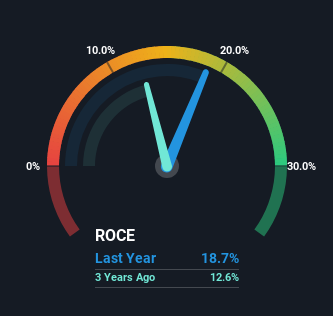- United Kingdom
- /
- Household Products
- /
- LSE:RKT
Reckitt Benckiser Group (LON:RKT) Is Looking To Continue Growing Its Returns On Capital

If you're looking for a multi-bagger, there's a few things to keep an eye out for. Firstly, we'd want to identify a growing return on capital employed (ROCE) and then alongside that, an ever-increasing base of capital employed. This shows us that it's a compounding machine, able to continually reinvest its earnings back into the business and generate higher returns. So on that note, Reckitt Benckiser Group (LON:RKT) looks quite promising in regards to its trends of return on capital.
Return On Capital Employed (ROCE): What Is It?
If you haven't worked with ROCE before, it measures the 'return' (pre-tax profit) a company generates from capital employed in its business. Analysts use this formula to calculate it for Reckitt Benckiser Group:
Return on Capital Employed = Earnings Before Interest and Tax (EBIT) ÷ (Total Assets - Current Liabilities)
0.19 = UK£3.4b ÷ (UK£28b - UK£9.3b) (Based on the trailing twelve months to June 2023).
Thus, Reckitt Benckiser Group has an ROCE of 19%. In absolute terms, that's a satisfactory return, but compared to the Household Products industry average of 11% it's much better.
Check out our latest analysis for Reckitt Benckiser Group

In the above chart we have measured Reckitt Benckiser Group's prior ROCE against its prior performance, but the future is arguably more important. If you're interested, you can view the analysts predictions in our free report on analyst forecasts for the company.
The Trend Of ROCE
Reckitt Benckiser Group has not disappointed in regards to ROCE growth. We found that the returns on capital employed over the last five years have risen by 66%. That's a very favorable trend because this means that the company is earning more per dollar of capital that's being employed. In regards to capital employed, Reckitt Benckiser Group appears to been achieving more with less, since the business is using 38% less capital to run its operation. Reckitt Benckiser Group may be selling some assets so it's worth investigating if the business has plans for future investments to increase returns further still.
For the record though, there was a noticeable increase in the company's current liabilities over the period, so we would attribute some of the ROCE growth to that. The current liabilities has increased to 34% of total assets, so the business is now more funded by the likes of its suppliers or short-term creditors. It's worth keeping an eye on this because as the percentage of current liabilities to total assets increases, some aspects of risk also increase.
The Key Takeaway
In a nutshell, we're pleased to see that Reckitt Benckiser Group has been able to generate higher returns from less capital. Investors may not be impressed by the favorable underlying trends yet because over the last five years the stock has only returned 8.7% to shareholders. Given that, we'd look further into this stock in case it has more traits that could make it multiply in the long term.
On a separate note, we've found 2 warning signs for Reckitt Benckiser Group you'll probably want to know about.
For those who like to invest in solid companies, check out this free list of companies with solid balance sheets and high returns on equity.
If you're looking to trade Reckitt Benckiser Group, open an account with the lowest-cost platform trusted by professionals, Interactive Brokers.
With clients in over 200 countries and territories, and access to 160 markets, IBKR lets you trade stocks, options, futures, forex, bonds and funds from a single integrated account.
Enjoy no hidden fees, no account minimums, and FX conversion rates as low as 0.03%, far better than what most brokers offer.
Sponsored ContentNew: AI Stock Screener & Alerts
Our new AI Stock Screener scans the market every day to uncover opportunities.
• Dividend Powerhouses (3%+ Yield)
• Undervalued Small Caps with Insider Buying
• High growth Tech and AI Companies
Or build your own from over 50 metrics.
Have feedback on this article? Concerned about the content? Get in touch with us directly. Alternatively, email editorial-team (at) simplywallst.com.
This article by Simply Wall St is general in nature. We provide commentary based on historical data and analyst forecasts only using an unbiased methodology and our articles are not intended to be financial advice. It does not constitute a recommendation to buy or sell any stock, and does not take account of your objectives, or your financial situation. We aim to bring you long-term focused analysis driven by fundamental data. Note that our analysis may not factor in the latest price-sensitive company announcements or qualitative material. Simply Wall St has no position in any stocks mentioned.
About LSE:RKT
Reckitt Benckiser Group
Manufactures and sells health, hygiene, and nutrition products worldwide.
Average dividend payer and fair value.


